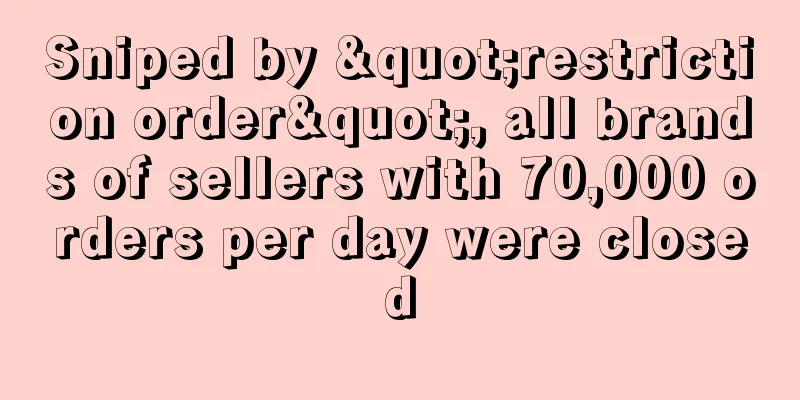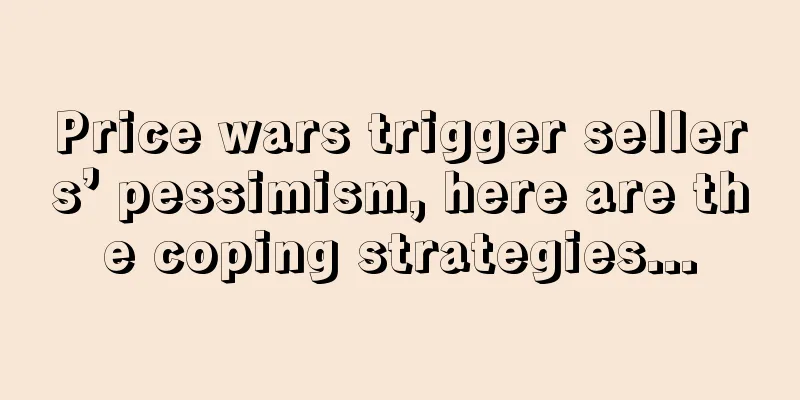Sniped by "restriction order", all brands of sellers with 70,000 orders per day were closed

|
Amazon's restrictions on brands are still expanding , and a large number of sellers have been banned from selling. One seller with more than 200,000 orders per month was hit hard, and more than 1,600 brands were restricted in just a few hours. The recent trend of "hard restrictions" on the platform has brought great uncertainty to sellers and triggered a new round of concerns.
Top selling brands are restricted
Earlier this month, Amazon seller Nick was hit by a sudden disaster, and almost all the brands he sold were suddenly closed. Before that , they did not receive any notification or email from Amazon.
Nick has a relatively large scale and has been a TOP seller on Amazon for many years, processing more than 200,000 orders per month (an average of about 70,000 orders per day), with a 100% feedback rate and an account health rating of 1,000.
At 3pm EST on September 4, Nick noticed that almost all brands sold on his account were restricted and needed to be re-approved before they could be sold, even those that had been approved before. In just a few hours, more than 1,600 brands were restricted, millions of stocks were stranded, and hundreds of people were out of work.
Later, in just 24 hours, Nick was re-restricted for over 2,000 brands. They have over 10,000 ASINs in their entire catalog, many of which are still active and selling despite being restricted 24 hours ago.
According to Nick, more than 100 brands have been banned from sale in the past few hours. Some of the brands they have been banned from selling include: Lysol, Australian Gold, Sun In, Nature's Bounty, Ansell, Microflex, Lavazza, Batiste, Duracell, NIVEA, Samever, Theraband, Jobst, Birchwood, New Life Spectrum, Purell, Conair, Halyard, Ozium, Welch Allyn, Arm & Hammer, Titebond, Rawz, Makita, Leviton, Nema Globe, Ferti-Lome, Oregon, Speed Stick, Smith, Fromm, etc.
What puzzled Nick was that all the products they purchased were from distributors, who were authorized by the brand and sold products to them as sellers, knowing that the products were sold on the Amazon market. Why would the brand they were selling be shut down?
In this regard, an industry insider said that the problem is that the dealer obtains brand authorization to sell to Nick, rather than the distributor authorizing Nick to sell as a third-party seller on Amazon. This is equivalent to the dealer obtaining brand authorization, not Nick obtaining authorization.
“Currently, all brands under our account have been restricted and all product listings are gradually being put on hold, ” Nick said. Other sellers (of the same size as theirs) are still keeping all listings and continuing to sell.
Although many brands are now restricting sales by third-party sellers, Nick still questions whether it is a bit strange that every brand he sells is restricted at the same time.
A senior seller said that large-scale brand restrictions are not accidental and the platform is carrying out a new round of screening and restrictions.
First, Amazon may remove a seller’s access to a category where there may be more than 100 brands, all with their own restrictions.
Secondly, a brand may have sent Amazon a "white list" of approved sellers. Sellers can contact the sales representative of the relevant brand to inquire about their white list and obtain brand authorization;
Finally, more and more brands provide a "white list" of sellers they approve. If a seller is not on the list, they are at risk of being targeted. They may even be punished for intellectual property infringement.
It’s hard to believe that a seller of Nick’s size has such poor risk control awareness! He actually ignored the platform’s recent brand “restriction order”.
Last month, many sellers found that their usually active ASINs were suddenly restricted. Most of the ASINs have been sold for many years, have a certain order base, and have a large amount of inventory. After the restrictions, product sales dropped sharply, and a large number of sellers suffered heavy losses. At that time, insiders warned that Amazon platform had implemented new restrictions on many brands, and robots would remove all unqualified sellers one by one.
Unpredictable brand thresholds raise concerns
Amazon’s expanded restrictions on brands and this “immediate/hard limit” trend have created a lot of uncertainty for sellers, especially as they prepare to place large orders for the fourth quarter.
A medium-to-large seller who claims to have hundreds of SKUs said, "We often place orders in units of hundreds for each SKU. This is driven not only by consumer demand, but also by Amazon's fee structure, which charges additional fees for products that are out of stock."
However, with the increasing number of cases of instant restrictions, where brands are suddenly restricted with little warning or explanation, this obviously poses a serious risk. Sellers may find themselves unable to sell products they have already purchased and face costly removal fees that could run into the thousands or even tens of thousands of dollars.
This is a huge challenge for sellers, especially as these restrictions from Amazon seem to be increasingly unpredictable and have been extended to more and more brands. The platform has responded that many categories, brands, and products require Amazon's approval to sell, and in some cases, restrictions and policies change.
In this environment, it is increasingly difficult for Amazon sellers to confidently place large orders with any brand. The possibility of a sudden ban poses a huge financial risk, making it difficult for sellers to make smart business decisions when inventory cannot be sold and the threat of high removal fees looms.
To address this, we believe Amazon should consider revising its policies, especially the removal fees associated with immediate /hard limits. Sellers should not be penalized for accidentally restricting the sale of inventory. Without greater transparency and predictability, the current situation prevents us from making the necessary investments to meet customer demand.
Given these concerns, we can’t help but ask : How can Amazon sellers feel comfortable investing in large orders if brands are suddenly restricted without any warning? The risk is high and would put our business at risk. We urge Amazon to review and improve its approach to brand restrictions to ensure fair treatment of third-party sellers.
Today, many brands have realized that their brand names are being abused and want to regain control. In fact, it is not Amazon that is exercising control, but Amazon is exercising control over the sellers selling the brand at the request of the brand owner.
As a platform, Amazon needs to be accountable to brand owners . Therefore, sellers must obtain authorization for the products they want to sell through the correct channels. If they cannot obtain authorization , they must be prepared to take the risk of selling the product in the future. Amazon always approves sellers to sell at the beginning , and then deactivates the seller's account after receiving complaints .
Amazon may not change their policy because if they do, the platform will face repeated lawsuits . For sellers, the idea of "Amazon approved me" to sell on the platform is outdated, and obtaining brand authorization is the only way out . Seller Restraining Order |
<<: Sales dropped 80%! Amazon sellers: Chinese sellers have taken over Amazon
Recommend
GBC is the agent of a new brand and has filed three cases in a row
Amazon has been cracking down on copyright infrin...
US e-commerce demand for multiple categories will grow in 2022
Recently, emarketer analyzed the US e-commerce ma...
Orders are delayed for up to 9 months, and the US furniture market is in serious shortage
The rise of the home office trend in 2020 has led...
What is Export Easy Logistics? Export Easy Logistics Review, Features
Export Easy Logistics is a subsidiary of Guangzho...
What is Meishe International Logistics Group Co., Ltd.? Meishe International Logistics Group Co., Ltd. Review, Features
Founded in 2004 and headquartered in Shanghai, Me...
One year after full hosting, cross-border e-commerce industry undergoes major reshuffle
"The good days may really be coming to an en...
No. 3 on the Best Sellers list, with over 8,000 reviews! Amazon’s electric fan sales soar
In recent years, although Home & Kitchen prod...
Big news! Clubhouse launches creator accelerator program
Some time ago, the voice chat social software Clu...
What is Auction.co.kr? Auction.co.kr Review, Features
Auction is the first e-commerce platform in South...
What is Native Deodorant? Native Deodorant Review, Features
Native Deodorant is an online distributor of deod...
What is Smallcase? Smallcase Review, Features
Smallcase is a fintech company building a trusted ...
Amazon's new insurance rules will take effect in 10 days, and individual sellers' insurance has been approved
Since Amazon issued its new insurance regulations...
The popularity of insect repellent equipment has soared, and Lazada’s three major categories have entered a booming sales mode!
The new year has begun, and sellers have returned...
Affecting sellers! Domestic cross-border independent station giants are sued by North American counterparts
For enterprises going overseas, independent websi...
Will you be fired if you frequently go to the bathroom? Amazon is sued again...
Recently, according to CNMO, Amazon was sued by a...









